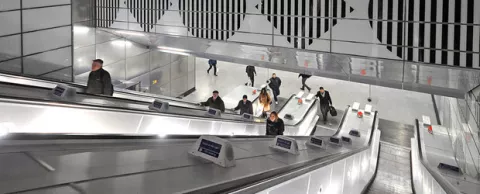
Underground metro stations are typically large -- but they don't need to be. Smaller stations reduce costs significantly and minimize disruption during construction, says Council Lead Partner CH2M. There are other advantages as well, including maintenance and safety. In the story below, we share some of the company's experience-based observations and insights. As you will see, smaller stations could be a perfect fit for many cities' transportation systems. – Doug Peeples
City populations are growing and there's no reason to think that trend will stop anytime in the next several years. In addition to straining city budgets, those growing populations also tax the ability of transportation systems to move all those people efficiently. While underground public metro systems are a good solution for crowded cities, most built today have a pretty big footprint—and that causes several problems.
In an article on the emergence of small underground metro stations, Anthony Harding, global technology lead for CH2M, outlined the numerous advantages and benefits of 'going small.'
The problems with 'big'
Today's metro stations are typically large, which also means a large hole in the ground during construction. The construction phase is extremely disruptive, often requiring temporary street closures. And it’s extremely annoying to citizens and businesses. Harding points out that utility diversion and protection is required for safe excavations (and that’s assuming agreements can be reached with utility companies). Maintenance also is an issue. It must be limited to the stations only because there's not enough space in the tunnels to maintain them while trains are in service.
And maybe most important: building a large metro station is very expensive.
Sometimes it's necessary to use a smaller footprint on the surface and tunnel to provide more space underground. But that is also a very expensive option and feasible only in areas with a suitable location and serious space limitations. Harding referred to New York and London as examples of the smaller surface footprint/tunneling approach.
Another way to do it
The small underground metro model features a large tunnel, large enough for two tracks and platforms. Equipment can be located inside the tunnel in rooms next to the platforms. Taking the platforms out of the station box substantially reduces its footprint. Emergency exits and maintenance access are also simplified. CH2M has considerable experience in small footprint stations, including two locations in London.
The small footprint model offers several advantages in addition to reduced cost and surface disruption. Some of them, according to Harding, are:
- Far fewer utility diversions are needed
- Because of the design, escape shafts aren't needed and that augments safety, reduces cost and construction time
- In-tunnel maintenance can be done while trains are running
- The stations are built to be expandable and modified. Track configurations can be changed and more stations can be added later.
Want to know more about smart transportation systems?
If your city is in need of a transportation system upgrade or other major changes, the Transportation chapter of the Smart Cities Readiness Guide provides guidance, the issues city planners should consider and the four targets that need to be achieved to reap the benefits of a truly smart transportation network.
Doug Peeples is a Portland, Oregon-based writer specializing in technology and energy. Follow @smartccouncil on Twitter.



